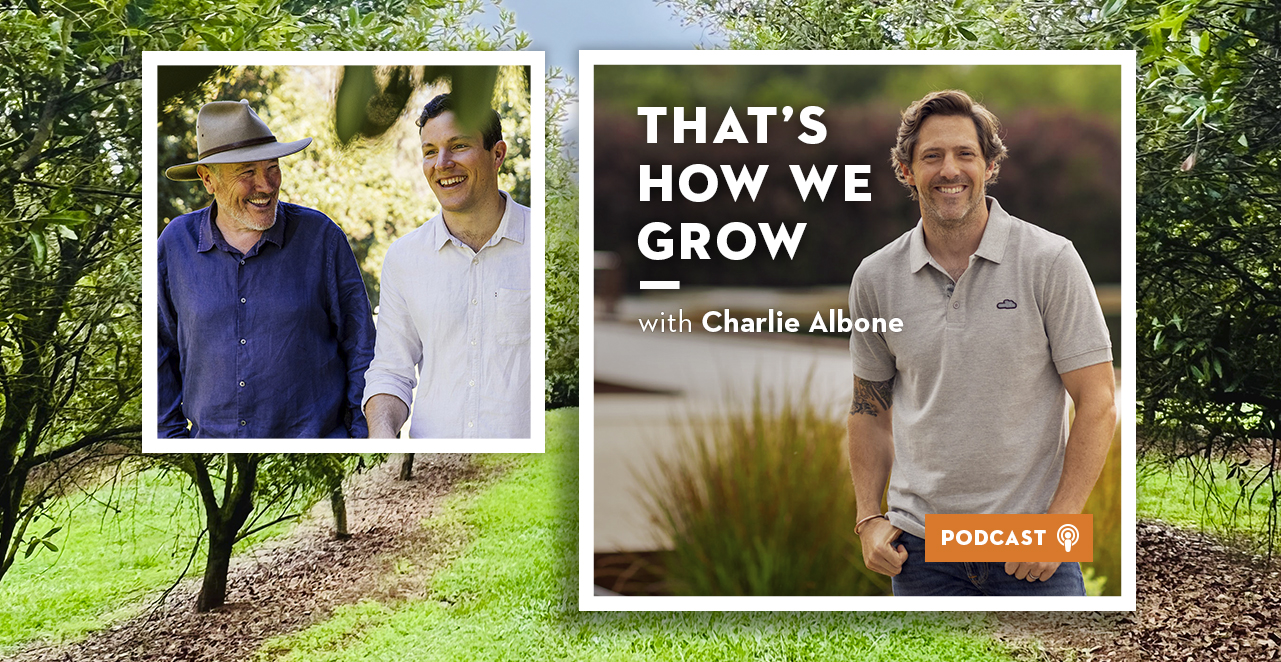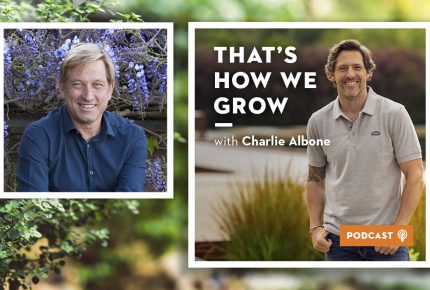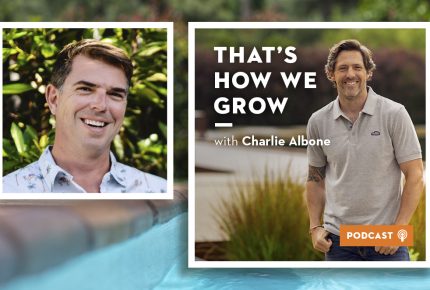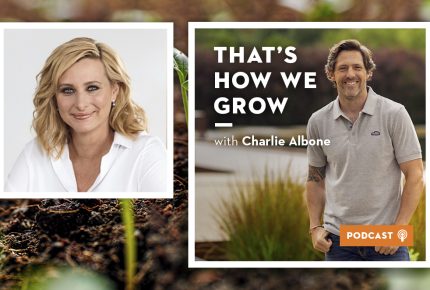
#Inspiration
SEASON 2 EPISODE 5: FAMILY PRODUCE AND BIODIVERSITY WITH BROOKFARM
Charlie: Hello, I’m Charlie Albone and welcome to Episode Five of Season Two of That’s How We Grow in partnership with Stihl Garden Power Tools. Healthy soil is vital for developing happy and thriving plants. Supporting this through sustainable gardening practices will encourage biodiversity through all levels of your garden, from the roots to the tips of your leaves.
Now imagine taking on a big piece of land that’s been cleared of its natural rainforest, is showing signs of significant erosion and looks bare. Then consider trying to make a living from this land. No doubt if you continue on this trajectory, the soil have very little nutrients to support your efforts.
Today’s guests are Martin and Will Brook, they did just that, taking on Brook Farm in the 1980s in Byron Bay. Buying an old dairy farm, they went about converting it into an incredible example of working with nature to support a healthy environment whilst growing delicious macadamia nuts.
What you see on the farm today is vastly different to what they started with. It’s going to be a great chat with Martin and Will about how they’ve rehabilitated the land, planting countless macadamia trees, supporting the rainforest and natural wildlife and building an amazing business.
Charlie: Through all of this, it’s time to get cracking with Martin and Will Martin and Will Brook from Brook Farm. Welcome to That’s How We Grow. How are you guys?
Martin and Will: Really well, yeah really well Charlie.
Charlie: So how on earth do you start macadamia farming? Tell me your story.
Martin: In 1988, we and another family, the Bradleys, decided that it was time for a sea change and we actually decided Byron Bay. But remember, this was quite early on- t’s not the Byron Bay of today, and that Byron Bay was the place we would all would take our young families and settle. I used to be in the film and TV business and a friend of ours was I think is producing what was it, Mission Impossible Two up on the Gold Coast.
And he was sent off, you know, to look for land. And he actually, you know, went away for a weekend, found this block of land on top of a hill overlooking Byron Bay. And then the auction happened and no one turned up to the auction. So we were the proud owners of 98 acres, 36 hectares of land in a very sad, run-down state. And then we got a weeds notice from the council, so we decided we had to do something about, you know, the land. We cleared it, we planted four and a half thousand macadamia trees, but we also planted 36,000 native trees, mostly subtropical rainforest.
Will: As you said in one sentence, it sounds nice and easy that we planted macadamia trees and regenerated rainforest. But one of the things that mum and dad are really good at was asking for advice and knowing, you know, if I’m in film and TV and in dentistry that, you know, growing things isn’t my strong suit as yet. Talking to the local farmers about what’s this, more crops, should we put it in. I remember, or they’ve talked about, you know, it was going to be farm stays or pecans or cattle or and, well, we’re looking at coffee as well.
Coffee. Yeah. And it’s the macadamias that was really popular as the Hawaiian nut back then but not the native Australian rainforest tree that it really is. And I think that’s something that really caught their eye. And when they said, you know, we planted 36,000, I think almost up to 45,000 rainforest trees now and those macadamias that was our life… Or my youth was! Every school holidays, we were in Melbourne at the time, was travelling up to the macadamia farm, planting trees, picking up rocks back down film and dentistry back up, farming back down, and then we’d have a farm manager in between as well.
There’s some awesome before and after photos on our website.
Charlie: I’ve seen, I’ve seen the pictures on your website, so the way you nonchalantly say “Oh, we’ve planted some trees in a rainforest is ridiculous. Like when you first bought the property, there was nothing there. It was really degraded, was it?
Martin: It was incredibly degraded. It was eroded. It was full of weed tree, camphor laurel, lantana rocks and lots and lots of boulders.
Charlie: How do you replant a rainforest? I mean, obviously you’ve got to get rid of the weeds. Do you improve the soil? Where do you get the plants from? Are they small seedlings that you plant? Like what’s the process?
Martin: Well, in those days there were very few nurseries. I mean, today it’s a different sort of deal. But again, through this amazing gentleman we met, we were put on to a very, very good subtropical rainforest nursery. So what you’ve got to do, basically, is that you’ve got to get rid of the weeds to begin with.
You then purchase trees that are pretty small. Obviously, you’ve got to dig the holes. You then use a bit of fertilizer. But the important thing is to cover them with straw. And if you can, if you can as well with woodchip, because the woodchip will actually break down and help the growth of those trees. And then in the old days and now it’s changed completely. You had this concept of planting the fastest growing pioneer tree in the middle, then a middle story tree as second circle.
And the third circle would be the trees that took longer to grow. Now, of course, all of that has gone out the window. You can plant anything anywhere apart from in those wet areas where you have specific trees that like, you know, wet soils.
Charlie: It seems like such a crazy impossible thing to do. The before and afters are so drastic. Was there ever a moment when you were doing the work and you thought, “Oh, this is all too much” or did you have the vision for it?
Will: There’s an aspect of it which is momentum. I mean, the two projects, the macadamias and the rainforests and then eventually the Brook farm, the business side, almost happened quite naturally. So the macadamias in the rainforest were almost done as two completely separate projects. And there’s like the particular passion for the macadamia and a passion for this regrowth regeneration, regenerating the big scrub, because it seemed like the right thing to do with that piece of land.
And there was a lot of work involved. But what we saw is the significant impact, positive impact that regenerating the rainforest had on the back of the macadamia farm, was quite stunning- and has really created the bedrock for everything that we do as a family now, like, we used to do all the standard macadamia farming things. And that’s why I said it was almost to separate. We fight the rats, we do all the normal spraying. This is back early nineties. Once the rainforest was at a mature stage, we got this advice saying, you know what, you’ve got a significant amount of bird life going on here.
Why don’t you, instead of baiting for these rats, just, just take the baits out and see what happens? And our rat damage went from like, high almost 10% down to extremely low single digits because we weren’t inadvertently killing off the natural pest managers. Your, barn owls or owls in general, birdlife, snakes or all of that type of stuff. And so the amount of inputs that are going into the farm in terms of poisons go down.
We also had increased pollination because we bringing all this other flora to the area and just creating an environment that the macadamias …the macadamias are rainforest trees, that’s where it’s supposed to be. And so those concepts we then take into the…and I’m skipping ahead a little bit, but taking into the muesli granola side of things, it’s like, it’s not we don’t do things just to be green or whatever, we do things because they just make sense. Being more sustainable has a better impact on our bottom line, which is the way that things should be.
Charlie: Should be! And I mean, that is an amazing thing to happen. It’s incredible that it is not only is better for the environment, but it’s better for the bottom line. So it’s like the perfect situation, isn’t it?
Will: Yeah. And you get better quality, better quality products. Yeah. And everything in between.
Charlie: So when you started growing the macadamias, how was setting that project up different to the rainforest? Was there more soil preparation? Was there larger trees? How did that work?
Martin: A lot more soil preparation, you know, the planting of the trees: by age, and it’s important where you actually planted them in terms of north south direction. But you know, in the early days we really, we really didn’t have, as Will says, you know, there wasn’t a traditional way of farming and I think about it now and I cringe when the concept of sort of calendar spraying would happen, you know, regardless of what nasty bugs were out there.
You know, you spray regardless.
Charlie: We’ve all done things that make us cringe!
Martin: And, you know, we were one of the very first, and I was overjoyed, the brilliant scientist up in Queensland- we had a huge problem with a horrible bug called the nutborer and he came up with this solution, whereby we would put out – and every year we do it, about 60,000 trichgrammatoidea wasp eggs, the eggs become into this wasp, the nutborer comes along lays an egg on the nut, within 30 seconds a trichgramma wasp come and inject the egg, kill it.
That’s it, we have no nutborer problem now!
Charlie: That’s amazing. So where do you, where do you get them from?
Martin: Well, we get them from a guy who breeds them up for us in Queensland.
Charlie: Do they come in the post? (Laughs)
Martin: They come in the post!
Will: It freaks out the postman, a box of wasps!
Martin: Yeah, he was very horrified the first time, the postmaster general was in Bangalow and he said, “What do you got there, Brooky?” I said, I’ve got 50,000 trichgramma wasps! He says, “I don’t think you should be putting that through the post!” Anyway. They take about three years before they hatch out. So we’re doing the same with spawning bugs, which is also a real issue. And we’re using anastay which is bred up in Chinese silkworms. So all the time, we’re endeavouring to work with nature, not against it. We’ve also just put 20 different boxes all around the place in our forest that was around the macadamias in terms of attracting micro bats, different sizes of birds, owls, sugar gliders, all these things are incredibly important in terms of pollination and issues, but also, you know, bringing the birdlife back and giving them a proper home.
Charlie: Yes. So how is the macadamia pollinated?
Martin: The macadamia is pollinated. Well, we all thought it was to do with sugar bees, not sugar bees sorry, honey bees. But in fact, what we’re finding is that insects play a very important role as well as bees. And we’re now quite big into the native bees, the carbonaria bee.
Charlie: Are they the stingless ones? The tiny ones?
Martin: Yeah, yeah, they’re very, very small and very cute, and they make the most beautiful, it’s called sugarbag honey, it’s incredibly good for you, but taste delicious.
Charlie: Wow. What’s a normal week or a normal day look like on the farm, as far as, I mean, is there certain things you have to do as far as soil improving, pest management, all that sort of stuff?
Martin: Yeah. I mean, it’s very cyclical. I mean, we as, as you probably know, have had the most challenging two years. And anyone who says that man-made climate change is it’s a bit of a farce, wants to come and live where we do, because the impacts of rain and continuous rain over quite a long period of time, you know, has certainly created some huge challenges, particularly in the macadamia industry, but not just the macadamias, I mean, in the sugar industry and all crops are affected.
So, you know, it’s in a sense climate change, that has got to have a bit of a rethink, I think.
Charlie: Yeah. You guys are real beacons for sustainability. How could the home gardener learn from what you’ve done? Obviously, people can’t plant a rainforest in their back garden. You know, they might have one macadamia tree. What kind of tips can you give the home gardener?
Martin: Well, the interesting thing is, you know, I’m very closely involved in, basically saving what’s left of this amazing rainforest that used to be. But, you know, there are so many subtropical rainforest trees and plants that in fact, will work in southern climes. And you can, in fact, plant a beautiful garden with native subtropical plants. But it’s basically kind of, you know, bit like a story in a way.
You know, it’s working out what works and what doesn’t. But also having a real really tuned into your environment and to your climate and, you know, trial and error a bit. But, you know, I think there are things that, you know, you can take from the big scale that we’ve done, into a garden.
Will: Yeah. I would just say that from my point of view, looking back, is that some of that advice, particularly if you’re looking at something like a subtropical, if you’re in a subtropical area or somewhere that can have rainforests, then find someone that knows that little bit about that, or that type of flora, that would be my number one thing. I just think a bit of knowledge and also a bit of patience, but not too much. Like you can come to the farm, anyone can come to the farm.
We’ve actually, just as this other business is called Cape Byron Distillery and we do rainforest tours through the farm and you can see, you know, you see the photos from our website and what it is now, that’s less than a generation to do a complete turnaround. Yeah, a 100% turnaround from barren camphor laurel, lantana, and privet covered land to a fully functioning, now self-sustaining rainforest.
So that’s quite heartening. Like it’s good to give people confidence, I guess that it’s not this-
Charlie: Absolutely! I mean, this is the biggest thing that kills a lot of gardeners, you know? But to see the change that you guys have gone through in such a short period really gives people hope. Yeah.
Will: Yeah. And it’s not impossible. I mean, there’s plenty of times I know that we’ve made mistakes in our plantings and done them different ways and put different varieties together, like that happens. That’s gardening. Despite all of that, we have this fully, fully functioning, amazing rainforest that I love. My favourite thing is bringing other people to the rainforest because you can, you can feel something special there. There’s something old and ancient and impactful about walking into a rainforest that you can see in peoples face that.
Will: So yeah that’s the thing is just is patience and…
Charlie: So are you guys keen gardeners or is the farm enough and do you just head off to the rainforest when you want your dose of greenery?
Martin: Yeah. Really. My, you know, I know when I was having a bad muesli outcome, I’d finish with the muesli and I’d find myself walking back into that rainforest, to get my head back in order again. There’s something incredibly satisfying about that environment. But, you know, the other thing is, you know, with the story of a beautiful garden, obviously with the right stuff in the ground is that… It’s what it does in terms of bringing birds back into that environment. It is just amazing. I wouldn’t say we’re great gardeners.
Will: We’re much stronger on trees rather than something like strawberries! Things like that. They don’t go so well in the Brook family home.
Martin: No.
Will: We’re more food trees! We’re very food motivated. So like we’ve had like bays, bays and avocados and lemons and oranges and those things. They go well, they’ll get the right love because, you know, that’s closely related to the dinner table or the breakfast table.
Martin: Yeah.
Will: And so I think that’s what motivates us.
Martin: And, you know, I had a mother who used to work on the notion, I come from Devon. And as you know, food is very important down there. And, you know, she would say if it moves, feed it. You know what I mean?
Charlie: Yes. So how do you how do you tread lightly on the farm when you obviously need large machinery to farm the macadamias, you know, for your pruning and stuff like that. How do you approach that?
Martin: It’s a very good question because, again, we’re learning more and more about soil compaction and how especially-
Charlie: With the rain.
Martin: Yeah, absolutely. So now, you know, there are there are different breed of kind of machinery out there which is, you know, for instance, our harvester, you know, our harvester tractor is really low impact and much, much lighter. You know, you’re not seeing these great big tractors anymore on farms where you might in a few, but it’s becoming less and less. And we, you know, we try and keep off the inter-row as much as possible.
Charlie: Right
Martin: So we let the grass grow, you know? It doesn’t look like bowling greens, but we don’t want it to look like bowling greens. We know those fibrous roots. You know, the more you go up and down and heavy machinery, the more compacted it becomes. So we try and stay off it as much as we can.
Will: And you’ll see that it on our farm compared to some of the other macadamia farms. Where it’s a pretty barren, you know, red dirt. Nice, good red dirt. But you can see that dirt, it’s not really lacking that sun harvesting concept with many other farms. So I think even having that grass covering really assist us, I’m sure helped us in the rain period because we didn’t… we had no erosion, we had none of those issues there if we didn’t have that concept.
Martin: Because grass, of course, you know, that’s the idea. You want to get the grass growing right up to the base of the trees is that, you know, and our farm in areas is pretty steep. And the amount of rain we actually get, that grass to slow it down. Will really, really reduce the impact of erosion.
Charlie: Yeah, it helps to bind the soil together with the rain, doesn’t it?
Martin: Yeah, absolutely. Absolutely. You know, it’s an old adage. They say it’s, it’s all in the soil, and it, it, it’s so critically important to get that right.
Charlie: Yes. You mentioned that you mulched quite heavily as well. Did you find during the rains that that would… if you’ve got steep grounds, just wash away? Or did you just mulch where it’s a bit flatter?
Martin: Well, we you know, we did get, I mean we had such huge amounts of rain. Yeah, we, we did, you know, we did get a bit of erosion but the work that we’ve done in terms of organic chicken litter, the compost, you know, when branches, when we have prune or when branches fall off trees, high winds, we always, always sort of chop them up and we put hat back under the tree, year after year after year that is building up and building up and building up. And you know, when we have these dramatic weather events, it really does help. It really does help hold that soil.
Charlie: Yes. So when you’re mulching up your garden clippings and bits and pieces like that, do you put them straight on the ground or do you age them so they don’t suck up the nitrogen
Martin: We leave them for a bit. Yeah, we do leave them for a bit and we’ll, you know, we’ll mix the chip with other things as well.
Charlie: Is that how you got the soil back? Because from what I understand, when you first got the property, there was hardly any soil. So by mulching a lot, that kind of creates some soil. Or did you have to do that? Yes. Yeah.
Martin: Absolutely. Absolutely. Because you want to create microbiological breakdown. I get so excited when I see fungi around the place, you know? Yeah. And it’s not just in the rainforest, you know? And that’s a sign that your rainforest is really beginning to advance, and also out in the field.
Charlie: So I guess one last question- is the recipe for the muesli a secret? Or does it just come down to good quality ingredients?
Will: Yes, it is a secret!
Charlie: Okay (laughs)
Will: Well we’re very… We’re control freaks, is what I would say. So we’re a little bit unique in our industry in that we create all our recipes and we’re a family business. We make everything ourselves. We don’t send it off to someone else to get contract back. So we control our own quality. And that’s then the same with the recipe side of things. That’s our, that’s our special little piece. It’s yeah, you know, we make it. Part of the reason it’s so delicious is it’s, quite complex. It’s a lot, it’s like 16 ingredients in most of our products!
Will: So I would say it’s challenging to copy and we like it that way.
Charlie: And mysterious, I like it!
Will: You know, it’s not rocket science. But we got to put a lot of love into it to get what we get at the end.
Charlie: Yeah, well, you guys are proof that sustainable practices are the way forward. You know, it’s amazing what you guys are doing as far as regeneration and the produce you’re creating and the fact that it is increasing your bottom line is just even better. It’s just proof for so many other people to give it a go.
Will: Yeah. Thanks mate.
Martin: Thanks very much.
Charlie: It is time for some community questions and we’ve got plenty of questions to follow through today. So let’s start with Ruby in Sydney. “Hi, Charlie. I hope you can help me rescue my lawn. How can I fix my lawn? It’s turned into mostly weeds. Any help will be appreciated.” Well, I can guarantee the only reason you’ve got weeds in your lawn is because it’s too compacted. So you’ll need to get an aerator and a scarifier onto it as soon as possible, and then fill in those holes with course sand so they don’t collapse on themselves. Try and get on top of the weeds and weed out as much as you can, but then give it a good fertilise and it should come good.
Next up, we’ve got Lewis asking. “I’ve recently moved into an apartment and I’d like to add some greenery to the place. I’m a novice gardener. What plants do you recommend and what ones can I start with? Well, if you’re looking at indoor plants, you can’t really go wrong with Zanzibar Gem, Devil’s” Ivy and a Philodendron. If you’re looking at putting some plants on a balcony, it’s most likely hot and dry. So maybe try some succulents.
And the next question is a succulent question at that!
Roxy in Sydney is asking, “Can I revive a dying succulent? Any tips to help these sick plants?” Now, the one thing that’s probably killing your succulents is poor drainage.
So succulents can actually take quite a lot of water. But if it sits around their roots, they really don’t like it, and they show the effect. So just plant them into straight sand and keep the water up to them and they will be just fine.
Up next, Ben is asking, “Hi, Charlie. Can you please settle a bet between my girlfriend and myself? I sing to my plants, encouraging them to grow faster. My girlfriend thinks I’m nuts for doing this. Does singing to your plants help them grow? I hope so”.
Well, Ben, I think you’re nuts. No, to be honest, I don’t do it to my plants.
But there is research that shows if you play music or sing to your plants, they grow stronger. I don’t know how they’ve tested this. I can’t substantiate it, but apparently it works. I don’t know. Go figure.
Okay. So the final question for today is from Anthony. “Hey, Charlie. My lawn is struggling and I’m looking to reseed it. What is the best time of year to do this? Do you have a particular type of grass seed you recommend?” Well, actually, I don’t recommend reseeding your grass. You can only use cool climate grasses when you go to see them.
Warmer climate grasses really need to be done by stolons. I haven’t had much success. The birds come in, they take the seed, and it’s very depressing. I think it’s much better to roll out turf. It’s done quickly and you can establish it quickly and have a better finish. It does cost a little more money. So if you’re trying to save a dollar, maybe get something like Sir Walter, cut it into strips and plant that out, keep on top of the weeds as they pop up, and it should fill in in no time. Do you have a gardening question you’d like me to answer? Well, send an email to Charlie@stihl.com.au and I’ll try and answer them in two weeks on our next episode.
The work Brook Farm has undertaken is incredible. Thanks again to Martin and Will for their time. It was so interesting talking to them the way they work with nature and not against it. They’re living proof that sustainable practices can work effectively, efficiently, and if you’re worried about the bottom dollar, they can make more money for you as well. It’s really interesting the way that they rehab the soil and they say it isn’t impossible. You just need a little bit of patience and that will pay a dividend.
Well, thanks for listening to. That’s How We Grow in partnership with Stihl Garden Power Tools need the tools to take on any garden challenge.
Go to the Stihl website or head to your local Stihl dealer today, there are over 600 local dealers across Australia and you can easily find your local dealer on the Stihl website follow Stihl on Instagram. It’s Stihl_AU and you can follow me on Instagram as well: Charlie_Albone. On our next episode, we’ve got my Better Homes and Gardens colleague Johanna Griggs. I’d like to say she’s a tough taskmaster at Better Homes and Gardens, but actually she’s not. She really is a lovely person and a keen gardener herself. Johanna is going to be sharing her tips on how to get your family and friends involved in the garden because she’s inspired so many herself.
This episode will be out in two weeks’ time. Don’t forget to check out the Stihl AU blog with plenty of great gardening advice, as well as my key seasonal tips and tricks. I’m Charlie Albone and thanks for listening. Until next time, goodbye.






